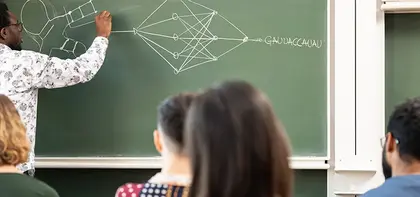
Event Overview
Discover the wide selection of events taking place at MPI MiS. From conferences, colloquia, workshops, and seasonal schools to regular events such as seminars, talks, and reading groups, we host all kinds of events for you to enjoy. Join us to expand your knowledge and network with leading researchers.
Selected Events
Events in 2014
-
Quantum ergodicity
- Nalini Anantharaman (Université Paris-Sud, Département de Mathématiques d'Orsay, France)
-
15:15
Markov Chain Aggregation for Agent-Based Models
- Sven Banisch (Universität Bielefeld)
-
15:15
Extremal process in nested conformal loops
- Elie Aidekon (Université Pierre et Marie Curie, Paris, France)
-
Shadowing property: State of art and perspectives
- Sergey Tikhomirov (MPI MiS, Leipzig)
-
15:15
Local limit theorem for ballistic random walk in random environments
- Ron Rosenthal (ETH Zürich, Switzerland)
-
11:00
Study of a model for reference-free plasticity
- Jens Wohlgemuth (MPI MiS, Leipzig)
-
11:00
A generalization of Wiener-Wintner theorem
- Tanja Eisner (Mathematisches Institut, Universität Leipzig)
-
15:15
Energy scaling law for the regular cone
- Heiner Olbermann (Rheinische Friedrich-Wilhelms-Universität Bonn, Hausdorff Center for Mathematics)
-
16:45
Preferential attachment networks: Robustness and Vulnerability
- Peter Moerters (University of Bath, Department of Mathematical Sciences, United Kingdom)
-
11:00
Gradient Gibbs Measures in Atomistic Systems
- Eris Runa (MPI MiS, Leipzig)
-
16:45
Free energy fluctuations for directed polymers in 1+1 dimension
- Patrik Ferrari (Universität Bonn, Germany)
-
11:00
On some methods in nonlinear partial differential equations and their applications to the Blackstock-Crighton-Westervelt rotational model equation
- Rainer Brunnhuber (Alpen-Adria Universität Klagenfurt)
-
11:00
Characterization of gradient Young measures under determinant constraints
- Konstantinos Koumatos (University of Oxford, Mathematical Institute, United Kingdom)
-
15:15
On the Gibbs states of the non-critical Potts model on
- Loren Coquille (Universität Bonn, Germany)
-
10:30
Some approximation and regularity results for fully nonlinear parabolic equations
- Jean-Paul Daniel (Université Pierre et Marie Curie, France)
-
11:30
On some methods in nonlinear partial differential equations and their applications to the Blackstock-Crighton-Westervelt rotational model equation
- Rainer Brunnhuber (Alpen-Adria-Universität Klagenfurt, Austria)
-
11:00
The concept of kinetic solution and well-posedness for conservation laws
- Martina Hofmanova (MPI MiS, Leipzig)
-
15:15
Stripe formation in frustrated Ising models with long-range interactions
- Alessandro Giuliani (Università di Roma Tre)
-
14:00
Convex minimization problems and nonexpansive type mappings in CAT(0) spaces
- Genaro López-Acedo (Universidad de Sevilla, Spain)
-
15:15
Quantitative stochastic homogenization of uniformly convex energy functionals
- Scott Armstrong (Université de Paris-Dauphine)
-
16:45
Boundary Vortices in Micromagnetics
- Radu Ignat (Institut de Mathématiques de Toulouse, France)
-
Actions of finitely generated groups and the shadowing property
- Sergey Tikhomirov (MPI MiS, Leipzig)
-
11:00
From rank-based interacting particles to hyperbolic systems of conservation laws
- Julien Reygner (Université Paris 6)
-
Invariant measures and the soliton resolution conjecture
- Sourav Chatterjee (Stanford University, USA)
-
15:15
Stability analysis for pattern forming systems with slowly evolving base states
- Andreas Münch (University of Oxford)
-
16:45
Bose-Einstein condensation: PDE aspects beyond the Gross-Pitaevskii mean field regime
- Dionisos Margetis (University of Maryland, Department of Mathematics, USA)
-
Ergodic Theoems for almost additive functions
- Felix Pogorzelski (Universität Jena)
-
10:15
An energy barrier and gamma limit in the Cahn Hilliard energy landscape
- Maria Westdickenberg (RWTH Aachen, Germany)
-
Metric entropy for finite time dynamics
- Hoang Duc Luu (Technische Universität Dresden)
-
15:15
Asymptotic behavior of KPP fronts in a periodic and time-varying medium
- James Nolen (Duke University, USA)
-
16:45
A Simple Proof of Global Existence for the 1D Pressureless Gas Dynamics Equations
- Michael Westdickenberg (RWTH Aachen, Germany)
-
11:00
From loop clusters of parameter 1/2 to the Gaussian free field
- Titus Lupu (Université Paris-Sud 11, France)
-
15:15
Convergence of the near critical Kac-Ising model to
- Hendrik Weber (University of Warwick)
-
16:45
Homogenization for Diblock-Copolymer models
- Hans Knüpfer (Ruprecht-Karls-Universität Heidelberg)
-
11:00
Parabolic equations with hysteresis
- Sergey Tikhomirov (MPI MiS, Leipzig)
-
11:00
Stochastic differential equations on graphs
- Hatem Hajri (University of Luxembourg, Luxembourg)
-
The supercritical Lane-Emden equation and its gradient flow
- Michael Struwe (ETH Zurich, Switzerland)
-
Advertisement Session for Lectures
- Lecturers of the summer term 2014
-
Introduction to fractional calculus and some applications
- Eva Janotta (Helmholtz Centre for Environmental Research, Leipzig, Germany)
-
15:15
Pattern formation in extended domains: a Landau-Lifschitz-Gilbert-Slonczewski equation for spintronic devices
- Jens Rademacher (Universität Bremen)
-
10:15
Small divisors problem in quasi-periodic homogenization
- Michael Goldman (MPI MiS, Leipzig)
-
13:30
The statistics of knots in polymers
- Marco Baiesi (University of Padova)
-
15:15
Persistence of integrable stable processes
- Thomas Simon (Université Lille 1, Villeneuve d'Ascq, France)
-
11:00
Quasiconvexity conditions when minimizing over homeomorphisms in the plane
- Barbora Benešová (RWTH Aachen, Germany)
-
A quick introduction to the Thompson group
- Dan Titus Salajan (Universität Leipzig)
-
15:15
Transporation-cost inequalities and rough paths
- Sebastian Riedel (Technische Universität Berlin, Germany)
-
15:15
Behaviour near the extinction time in self-similar fragmentation chains
- Christina Goldschmidt (University of Oxford, United Kingdom)
-
16:45
On incompressible two-phase flows with phase transitions
- Gieri Simonett (Vanderbilt University, Nashville, USA)
-
The concentration of measure phenomenon
- Michel Ledoux (Université Toulouse III)
-
10:00
On the notion of porosity and its applications in Geometric Measure Theory
- Andrea Marchese (MPI MiS, Leipzig)
-
Are You Afraid of the Dark Matter? Making Sense of Fluctuating Brain Activity
- Jean Philippe Thivierge (University of Ottawa, Laboratory for the Quantitative Investigation of Brain and Behaviour (QuIBB) School of Psychology and Center for Neural Dynamics, Canada)
-
A general invariance principle for variable speed random walks on trees
- Wolfgang Löhr (Universität Duisburg-Essen)
-
15:15
A phase field model for the optimization of the Willmore energy in the class of connected surfaces
- Patrick Dondl (Durham University, United Kingdom)
-
16:45
Diffusion in fluid flows
- Alexei Novikov (Penn State University, Department of Mathematics)
-
15:00
Phoretic swimmers
- Guillermo Zecua (Universität Leipzig, Institut für Theoretische Physik, Germany)
-
15:15
Particle motion and irreversibility of turbulent flows
- Alain Pumir (Ecole Normale Supérieure de Lyon)
-
General relativity, experiment and theory
- Piotr Chruściel (Universität Wien, Austria)
-
16:45
Orbital free density functional theory of out-of-plane charge screening in graphene
- Jianfeng Lu (Duke University, Mathematics Department)
-
15:15
Inspired soft matter through experimental geometry
- Myfanwy Evans (Universität Erlangen-Nürnberg, Theoretische Physik I, Germany)
-
16:45
The
- Nadine Große (Mathematisches Institut, Universität Leipzig)
-
11:00
Hot Brownian motion
- Gianmaria Falasco (Universität Leipzig, Institut für Theoretische Physik, Germany)
-
Fundamental Groups in Algebraic Geometry, and Local Systems
- Hélène Esnault (Freie Universität Berlin, Germany)
-
Modelling adhesion-induced protein organization in cellular membranes
- Ana‐Sunčana Smith (Friedrich-Alexander Universität Erlangen-Nürnberg, Germany)
-
13:30
Phase separation in active colloids
- Michael Cates (University of Edinburgh, School of Physics and Astronomy, United Kingdom)
-
15:15
The spectral radius of homogeneous order-preserving maps and the persistence of dispersing two-sex populations (partially joint work with Wen Jin)
- Horst Thieme (Arizona State University, USA)
-
The Physics of Cellular Motility
- Michael Cates (University of Edinburgh, School of Physics and Astronomy, United Kingdom)
-
16:45
Paracontrolled distributions and SPDEs
- Massimiliano Gubinelli (Université Paris-Dauphine, France)
-
16:15
Regularity for variational problems on Riemann surfaces
- Benjamin Sharp (Imperial College London, United Kingdom)
-
10:00
Continuos maps, their attractors and stability.
- Emma D'Aniello (Seconda Università degli Studi di Napoli, Italy)
-
11:00
Measurement of F-actin tube radius fluctuations of different sample history and their orientation distribution in three dimensions
- Evelin Jaschinski (Universität Leipzig, Institut für Theoretische Physik, Germany)
-
15:15
Structure of branch sets of harmonic functions and minimal submanifolds
- Brian Krummel (University of Cambridge, United Kingdom)
-
Ist Qualitätsmanagement in der universitären Wissenschaft oder Universität umsetzbar?
- Bernd Burchard (Elmos Semiconductor AG, Dortmund, Germany)
-
16:45
Martingale transport, Skorokhod embedding and peacocks
- Xiaolou Tan (Université Paris-Dauphine, France)
-
Recent progress in high-dimensional percolation.
- Remco van der Hofstad (Eindhoven University of Technology, Netherlands)
-
15:15
Regularity of free boundaries in anisotropic capillarity problems and the validity of Young's law
- Guido de Philippis (Universität Zürich, Institut für Mathematik)
-
16:45
Two topics on regularity and blow-up for the dyadic model.
- Marco Romito (Università di Pisa, Italy)
-
11:00
Densities for the Navier-Stokes equations with noise
- Marco Romito (Università di Pisa, Italy)
-
11:00
High Rayleigh number convection in Porous Media, and implications for CO_2 storage
- Duncan Hewitt (University of Cambridge, United Kingdom)
-
15:15
Invariant measures for stochastic conservation laws
- Arnaud Debussche (Ecole normale supérieure de Rennes, France)
-
Synchrotron SOLEIL – Converging Science and Technology
- Stefan Kubsky (Synchrotron SOLEIL, France)
-
16:45
Prediction without probability: a PDE approach to a model problem from the machine learning literature
- Robert Kohn (Courant Institute of Mathematical Sciences, New York University)
-
13:15
From harmonic analysis problems to Hamilton--Jacobi--Bellman PDE and back to harmonic analysis problems.
- Alexander Volberg (Michigan State University, USA)
-
15:15
From harmonic analysis problems to Hamilton--Jacobi--Bellman PDE and back to harmonic analysis problems.
- Alexander Volberg (Michigan State University, USA)
-
15:15
Recent developments on spectral radius of adjacency matrix
- Dragan Stevanović (University of Primorska, Slovenia / University of Nis, Serbia)
-
16:45
Cheeger constant, spectral clustering and eigenvalue ratios of Laplacian
- Shiping Liu (University of Durham, United Kingdom)
-
Modeling metastability in complex systems
- Eric Vanden-Eijnden (New York University, Courant Institute, USA)
-
Solids under extreme sample conditions
- Thomas Hermannsdörfer (Helmholtz-Zentrum Dresden-Rossendorf, Germany)
-
16:45
Density fitting and multipole approximations in periodic local quantum chemical methods: Using physical principles in tensor decompositions
- Denis Usvyat (Universität Regensburg, Germany)
-
13:15
From harmonic analysis problems to Hamilton--Jacobi--Bellman PDE and back to harmonic analysis problems.
- Alexander Volberg (Michigan State University)
-
15:00
Shaping concepts in the dynamics of recurrent neural networks
- Herbert Jäger (Jacobs University Bremen)
-
15:15
From harmonic analysis problems to Hamilton--Jacobi--Bellman PDE and back to harmonic analysis problems.
- Alexander Volberg (Michigan State University, USA)
-
11:00
On the Mean-Field Dynamics of a Fermion Gas
- Claudia Raithel (The University of Texas at Austin, USA)
-
Transformations at megabar pressures
- Mikhail Eremets (Max-Planck-Institut für Chemie, Germany)
-
16:45
Nonlocal curvature flows
- Marcello Ponsiglione (Sapienza Università di Roma, Dep. of Mathematics, Italy)
-
13:15
From harmonic analysis problems to Hamilton--Jacobi--Bellman PDE and back to harmonic analysis problems.
- Alexander Volberg (Michigan State University, USA)
-
13:30
An attempt of extending the splash function in aeolian saltation to different grain sizes
- Maik Weßling (Universität Leipzig, Institut für Theoretische Physik, Germany)
-
11:00
Statics and dynamics of dislocations: A Gamma-convergence approach.
- Lucia de Luca (Technische Universität Dresden, Germany)
-
15:15
An axiomatic approach to quantum information
- Pierfranceso La Mura (Handelshochschule Leipzig)
-
16:45
Strategic teaching and learning in games
- Burkhard Schipper (University of California, Davis, Department of Economics, USA)
-
Dual Roles for Single Molecules: Light Sources for 3D Nanoscopy and Reporters of Multivariate Dynamics in Solution
- William Esco Moerner (Stanford University, Department of Chemistry, USA)
-
14:00
Kombiniertes schematisches Modell zur Beschreibung inelastischer Effekte an Zellaggregaten
- Paul Mollenkopf (Universität Leipzig, Institut für Theoretische Physik, Germany)
-
Internally Coupled Ears (ICE): the cool part of sound localization
- Leo van Hemmen (Technische Universität München, Germany)
-
15:15
Seamless Bridging of Quantum Mechanics with Mechanics and Electronic Structure Calculations on Macroscopic Scales
- Vikram Gavini (University of Michigan at Ann Arbor, USA)
-
16:45
Hamiltonian dynamics of fluids and vortex sheets.
- Boris Khesin (University of Toronto, Department of Mathematics, USA)
-
16:15
The formal solution space and formal integrability of non-linear PDE's
- Markus J. Pflaum (University of Colorado, Boulder, USA)
-
11:00
Kinetic formulation for nonlinear conservation laws
- Marc Josien (Ecole Polytechnique, Paris, France)
-
How to use a Hopfield recurrent neural network trained on natural images to perform state-of-the-art image compression
- Christopher Hillar (UC Berkeley, Redwood Center For Theoretical Neuroscience, USA)
-
15:15
Mathematical problems in fusion research
- Per Helander (Max-Planck-Institut für Plasmaphysik, Germany)
-
16:45
A Liouville Property for Isotropic Diffusions in Random Environment
- Benjamin Fehrman (University of Chicago, USA)
-
Geometric Methods for Statistical Learning and Data in High-Dimensions
- Mauro Maggioni (Duke University, USA)
-
16:15
Topological fermion systems: Geometry and analysis on quantum spaces
- Felix Finster (Universität Regensburg)
-
15:15
Front Propagation in Sharp and Diffuse Interface Models of Stratified Media
- Cyrill Muratov (New Jersey Institute of Technology, Newark, Germany)
-
14:00
Singular Stochastic PDEs - A Short introduction to the theory of Regularity Structures
- Joscha Diehl (Technische Universität Berlin, Germany)
-
14:00
Singular Stochastic PDEs - A Short introduction to the theory of Regularity Structures
- Joscha Diehl (Technische Universität Berlin, Germany)
-
14:00
Singular Stochastic PDEs - A Short introduction to the theory of Regularity Structures
- Joscha Diehl (Technische Universität Berlin, Germany)
-
15:15
Singularities and Instantons
- Rainer Grauer (Ruhr-Universität Bochum, Germany)
-
14:00
Complexity bounds for continuum versions of eigenfunction-embedding algorithms
- Jim Portegies (MPI MiS, Leipzig)
-
Lecture Advertisement Session
- Lecturers of Winter Term
-
11:00
Calibrations and the Plateau problem
- Luca Spolaor (Universität Zürich, Switzerland)
-
15:15
Non-backtracking spectrum of random graphs
- Charles Bordenave (Université de Toulouse III, France)
-
14:00
Squashed entanglement, k-extendibility, quantum Markov chains, and recovery maps
- Andreas Winter (Universitat Autònoma de Barcelona, Spain)
-
16:15
The Klyachko paradigm in theoretical chemistry
- José M. Gracia Bondía (Universidad de Zaragoza, Spain, & Universidad de Costa Rica)
-
10:00
Shadowing property. Probabilistic aspects.
- Sergey Tikhomirov (MPI MiS, Leipzig)
-
11:00
Oxide structures: From atomically flat layers to nanowire forests
- Marius Grundmann (Universität Leipzig, Institut für Experimentelle Physik II)
-
Modulated Fourier expansions for continuous and discrete oscillatory systems
- Christian Lubich (Universität Tübingen, Germany)
-
13:15
A geometrical description of the impact process of particles onto 2D granular packings
- Maik Weßling (Universität Leipzig, Institut für Theoretische Physik, Germany)
-
14:00
Shadowing property. Probabilistic aspects.
- Sergey Tikhomirov (MPI MiS, Leipzig)
-
15:15
An analytical verification of a quasicontinuum method
- Anja Schlömerkemper (Universität Würzburg, Germany)
-
16:45
Extreme events in fluid dynamics -- Instantons in turbulent flows
- Tobias Grafke (Weizmann Institute of Science, Israel)
-
15:15
Modeling peak interaction forces of soft materials with dynamic AFM
- Horacio A. Vargas Guzmán (Universität Leipzig, Institut für Theoretische Physik, Germany)
-
15:15
Mutual attractions of floating objects: an idealized example
- Robert Finn (Stanford University, USA)
-
15:15
Shadowing of approximate trajectories in dynamical systems: several results and problems
- Sergei Pilyugin (St.-Petersburg State University, Russia)
-
Numerical Studies of the Quantum Adiabatic Algorithm
- A. Peter Young (University of California, Physics Department, USA)
-
16:45
Normal Approximation for Conic Intrinsic Volumes: Steining the Steiner Formula
- Ivan Nourdin (University of Luxembourg, Luxembourg)
-
Multiple time scale dynamics and geometry of a model for bipolar disorders
- Ilona Kosiuk (MPI MiS, Leipzig)
-
15:15
A direct approach to Plateau's problem
- Francesco Ghiraldin (Universität Zürich, Institut für Mathematik, Switzerland)
-
Experimental NMR and Computational Molecular Modeling Investigation of the Surfaces and Interlayer Galleries of Layer Structure Materials
- R. James Kirkpatrick (College of Natural Science Michigan State University East Lansing, Departments of Geological Sciences and Chemistry)
-
15:15
Spectra of locally symmetric spaces and their asymptotic properties
- Tobias Finis (Universität Leipzig)
-
Black Holes on a Computer
- Bernd Brügmann (Friedrich-Schiller-Universität Jena, Theoretisch-Physikalisches Institut, Germany)
-
Non-equilibrium steady states and charge fractionalization in Luttinger liquids
- Bernd Rosenow (Universität Leipzig, Institut für Theoretische Physik, Germany)
-
16:45
Carleson meets Calderón
- Daniel Faraco (Autonomous University of Madrid, Spain)
-
Collective neural dynamics and information processing
- Viola Priesemann (MPI für Dynamik und Selbstorganisation, Göttingen, Germany)
-
15:15
On the mathematical justification of reduced models for hydrodynamic problems and pattern forming systems
- Wolf-Patrick Düll (Institut für Analysis, Dynamik und Modellierung, Universität Stuttgart)
-
16:45
Self-Assembly: Variational models, Energy Landscapes, and Metastability
- Rustum Choksi (McGill University, Montreal)
-
Towards the mathematics of quantum field theory
- Frédéric Paugam (Institut de Mathématiques de Jussieu)
-
11:00
On the extension of Lipschitz functions
- Philippe Logaritsch (MPI MiS, Leipzig)
-
Nuclear structure from laser spectroscopy of muonic atoms
- Randolf Pohl (Max-Planck-Institut für Quantenoptik, Garching, Germany)
-
16:45
Strong and weak solutions to stochastic Landau-Lifshitz equations
- Zdzislaw Brzezniak (University of York, Department of Mathematics, United Kingdom)
-
Records in a changing world: From global warming to financial markets
- Joachim Krug (Universität Köln, Institut für Theoretische Physik, Germany)
-
11:00
Proofs and generalizations of the Clausius-Mossotti formulas for random inclusions
- Mitia Duerinckx (Université Libre de Bruxelles, Belgium)
Stay Informed About Our Events
Subscribe to our newsfeed: Link to the XML newsfeed
Import our calendar: Download ICS file
Visit Us Visit Us
Please use the entrances Kreuzstr. 7a (rooms A3 01, E2 10) and Kreuzstr. 7c (rooms G3 10, G2 01), both in the inner courtyard, and go to the 2nd or 3rd floor. To reach the Leibniz-Saal (E1 05), use the main entrance Inselstr. 22 and go to the 1st floor.
Please note: The doors will be opened 15 minutes before the start of an event and will be locked after it has begun!





